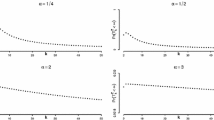Abstract
We consider a discrete-time population dynamics with age-dependent structure. At every time step, one of the alive individuals from the population is chosen randomly and removed with probability \(q_k\) depending on its age, whereas a new individual of age 1 is born with probability r. The model can also describe a single queue in which the service order is random while the service efficiency depends on a customer’s “age” in the queue. We propose a mean field approximation to investigate the long-time asymptotic behavior of the mean population size. The age dependence is shown to lead to anomalous power-law growth of the population at the critical regime. The scaling exponent is determined by the asymptotic behavior of the probabilities \(q_k\) at large k. The mean field approximation is validated by Monte Carlo simulations.





Similar content being viewed by others
References
Murrey, J.D.: Mathematical Biology. I. An Introducation, 3rd edn. Springer, New York (2002)
Hoppensteadt, F.C.: Mathematical Theories of Populations: Demographics, Genetics and Epidemics (Volume 20 of CBMS Lectures). SIAM Publications, Philadelphia (1975)
Hoppensteadt, F.C.: Mathematical Methods of Population Biology (Cambridge Studies in Mathematical Biology). Cambridge University Press, Cambridge (1982)
Brauer, F., Castillo-Chavez, C.: Mathematical Models in Population Biology and Epidemiology, 2nd edn. Springer, New York (2012)
Takacs, L.: Introduction to the Theory of Queues. Oxford University Press, New York (1962)
Gross, D., Harris, C.M.: Fundamentals of Queueing Theory. Wiley, New York (1998)
Bolch, G., Greiner, S., de Meer, H., Trivedi, S.: Queueing Networks and Markov Chains. Wiley, New York (1998)
van Houdt, B., Lenin, R.B.: Delay distribution of (im)patient customers in a discrete time D-MAP/PH/1 queue with age-dependent service times. Queueing Syst. 45, 59–73 (2003)
McKendrick, A.G.: Applications of mathematics to medical problems. Proc. Edinb. Math. Soc. 44, 98–130 (1926)
Keyfitz, B.L., Keyfitz, N.: The McKendrick partial differential equation and its uses in epidemiology and population study. Math. Comput. Model. 26, 1–9 (1997)
Webb, G.F.: Theory of Nonlinear Age-Dependent Population Dynamics. Marcel Dekker, New York (1985)
Gurtin, M.E., Maccamy, R.C.: Non-linear age-dependent population dynamics. Arch. Ration. Mech. Anal. 54(3), 281–300 (1974)
Gurtin, M.E., Maccamy, R.C.: Some simple models for nonlinear age-dependent population dynamics. Math. Biosci. 43, 199–211 (1979)
Cushing, J.M., Saleem, M.: A predator prey model with age structure. J. Math. Biol. 14, 231–250 (1982)
Busenberg, S., Iannelli, M.: Separable models in age-dependent population dynamics. J. Math. Biol. 22, 145–173 (1985)
Swart, J.H.: Stable controls in age-dependent population dynamics. Math. Biosci. 95, 53–63 (1989)
Rudnicki, R. (ed.): Mathematical Modelling of Population Dynamics, vol. 63. Banach Center Publications, Warszawa (2004)
Acknowledgments
The author acknowledges partial support under Grant No. ANR-13-JSV5-0006-01 of the French National Research Agency.
Author information
Authors and Affiliations
Corresponding author
Appendix: Exact Solution for a Fixed Death Age Model at the Critical Regime
Appendix: Exact Solution for a Fixed Death Age Model at the Critical Regime
We derive the exact solution for the particular case with \(r = 1\), \(q_k = 0\) for \(k \le T\), and \(q_k = 1\) for \(k > T\). In other words, a new individual is added at each time step, while a uniformly chosen individual is removed if its age exceeds T.
We split the population into “young” (\(k \le T\)) and “old” (\(k > T\)) individuals according to their age. For the first T steps, the population grows linearly with time: the number of young individuals is t, while there is no old individuals. For \(t > T\), the number of young individuals is fixed because at every time step, a new young individual is added while one young individual becomes old. In turn, the number \(\tilde{\eta }_t\) of old individuals at time t is a random variable which follows simple dynamics:
In fact, at time t, the probability to choose an old individual is \(\tilde{\eta }_t/(\tilde{\eta }_t + T)\), in which case this individual is removed, and the number of old individuals is not changed. In turn, with the complementary probability \(1 - \tilde{\eta }_t/(\tilde{\eta }_t +T)\), the chosen individual is young and is thus not removed. As a consequence, the number of old individuals is increased by 1. This process is Markovian since the next state is fully determined by the current state.
Let \(Q_n(t)\) be the probability that \(\tilde{\eta }_t = n\) or, equivalently, \(\eta (t) = n+T\), where \(\eta (t) = \tilde{\eta }_t + T\) is the total number of individuals (i.e., the population size). In analogy with random walks, one can write the master equation on \(Q_n(t)\):
where \(\kappa _n \equiv n/(n+T)\). In fact, the state \(\tilde{\eta }_t = n\) can be achieved either from the same state at the earlier time (with probability \(\kappa _n\) for not moving), or from the state \(\tilde{\eta }_{t-1} = n-1\). Applying this relation repeatedly, one can express \(Q_n(t)\) in terms of the probabilities \(Q_{n-1}(t')\) at earlier times \(t'\):
Note that the upper limit was set to \(t-n+1\) instead of t since \(Q_{n-1}(j) = 0\) for \(j < n-1\) (since the population can only increase by one per time step). The initial condition for the master equation is \(Q_n(T) = \delta _{n,0}\), i.e., no old individual at the beginning of the diffusive phase.
The above equations can be solved exactly:
where the coefficients \(c_{n,j}\) are
The moments of the old population size are
where
For instance, one finds
from which
The mean population size is therefore
We checked numerically that this solution is very close to the mean population size obtained in Sect. 4.1.
Rights and permissions
About this article
Cite this article
Grebenkov, D.S. Anomalous Growth of Aging Populations. J Stat Phys 163, 440–455 (2016). https://doi.org/10.1007/s10955-016-1488-x
Received:
Accepted:
Published:
Issue Date:
DOI: https://doi.org/10.1007/s10955-016-1488-x




